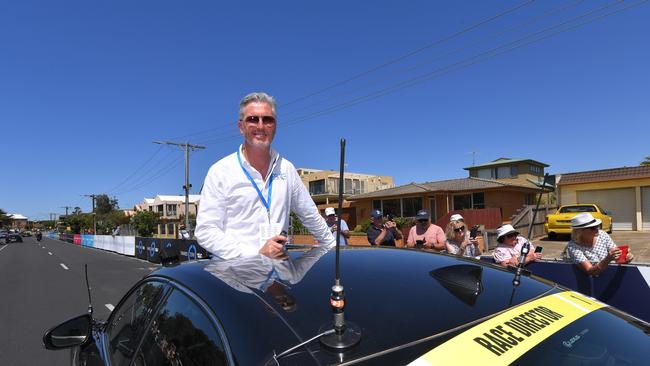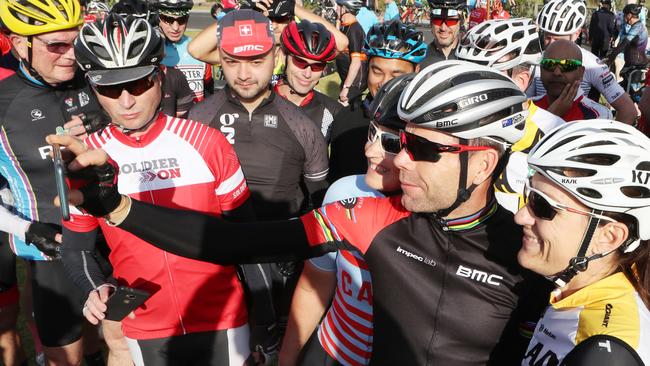Cadel Evans Great Ocean Rd Race director Scott Sunderland shares his intimate secrets on the course’s design
From dealing with local police, being across school bus timetables to informing local farmers, there’s plenty of balls to juggle with the region’s elite cycling event, its chief architect says.

Geelong
Don't miss out on the headlines from Geelong. Followed categories will be added to My News.
Geelong will once again have a front row view of the “Formula 1 of cycling” next weekend when the prestigious Cadel Evans Great Ocean Rd Race rolls into town.
The world class cycling event will feature UCI WorldTour elite men’s and women’s competitors weaving their way through the scenic roads of Geelong, Bellarine and the Surf Coast on January 27 and 28 respectively
And with more than 100,000 people expected to descend on the region for the five-day cycling carnival, and action broadcast to 140 countries, how do you plot a course which both pleases and tests the world’s best, while providing a memorable experience for fans?
This year’s event will have a degree of familiarity for starters.

The race’s architect, and tournament director, Scott Sunderland. told this publication the 2024 edition would see the event replicate the course changes of last year — essentially running the race in the opposite direction.
Starting and ending at the Geelong waterfront, the race will wind through Highton, Ceres Barrabool and Moriac before diverting to the coast, with plenty of echelons expected within the peloton as they race the exposed 13th Beach stretch.
There will also be the “punchy ascent” of the famous Challambra Climb, a pivotal 830m stretch, Sunderland said.
“If you really want to see the pain, the grimaces on the riders’ faces, that’s the place to be,” Sunderland said.

Sunderland has drawn on his own experience as a cyclist to “get the recipe right” later this month, with the men and women facing 176km and 143km trips respectively on January 27.
“I’ve got to know the area well over the last 12 years,” Sunderland said.
“I use my experience from being a rider myself, then as a race director and also team manager.
“You want a dynamic course which creates opportunities for riders ... something the riders will enjoy.
“You’ve got the Formula 1 of cycling in town.”

Sunderland said he would study the region’s terrain and look for opportunities.
However, there are plenty of operational challenges to consider, like council and business objections, school and bus timetables, railway crossings, police feedback on traffic management to the demands of broadcast vehicles and emergency services.
The course must also stay away from local hospitals and keep local farmers in the know and off local roads at certain times.
It’s why organisers have a 10-minute window for competitors and support vehicles to get out of Lorne once the shotgun sounds for the Surf Coast Classic on January 25.
Unlike some sports like cricket, elite cycling does not have designated breaks in play, or is stopped by the elements, so that’s one area where Sunderland has to get creative.

“If you need to support your riders, you need to have an event which creates a bit of a pause in it,” he said.
“A bit of straight road, flatter road, so if any riders need to do any mechanical repairs.
“You just release the pressure at the right time, it’s bit like a basketball time out.
“You don’t have that in cycling, so you need to create that in the course itself.
“But we need it to be challenging.”
That’s where the terrain, and local elements like Bellarine’s weather, comes to the fore.
However, he believed the course would be a treat for fans and riders, allowing for varied weather conditions and the opportunity for any kind of competitor to win.
“Bellarine can experience everything in one day ... from 35 degrees to blowing a gale with hail and wind,” he said.
“That’s why cycling is so fantastic, there’s no need to stop the match or stop the race, they’ll keep racing in those kinds of conditions.”

Sunderland said when it comes to designing a course, the worst thing you can do is over analyse things.
“Sometimes we just need to allow the riders to do what they do,” he said.
“You don’t always need to overthink it.”
He told this publication that familiarity would allow competitors to scheme, strategise and attack the race harder this year.
“The teams and riders see it’s the same as last year, they now know from their tactics and strategies of what worked and what didn’t work,” Sunderland said.
“They were riding defensively, they didn’t really go out aggressively. I suspected they would have but they didn’t, which was quite surprising to be honest.”
He said teams were apprehensive last year and were unsure of what to make of the new course.
“What teams want from a course and how they prepare for our race is always a big consideration,” Sunderland said.
“There will be no surprises, so they can plan well in advance and bring in a little bit more strategy and tactics.”
The five-day event will begin with the city-based, 25-lap women’s criterium on January 24.
“The last five or six (laps) ... it’s going to be tough,” he said.
“I’m excited about it, it’s a great way to kick off the week.”
Following the criterium will be the men’s Surf Coast Classic on January 25, which concludes in Torquay.

“I see it as an exciting event and it could go either way with a close finish,” he said.
“The rolling hills coming into Torquay and then that flat, fast finish onto the Esplanade is going to be pretty cool.
“It’s a beautiful part of the world.”
There will also be the Family Ride along the Geelong waterfront on January 26, followed by the People’s Ride the next day, where social riders can take on the same course as the pros.
“This is like walking out onto a cricket field, whether it be the MCG or centre court (at the Australian Open),” he said.
“I think the mums and dads are just as excited as the kids (about the Family Ride) to be honest.”
More Coverage
Originally published as Cadel Evans Great Ocean Rd Race director Scott Sunderland shares his intimate secrets on the course’s design





